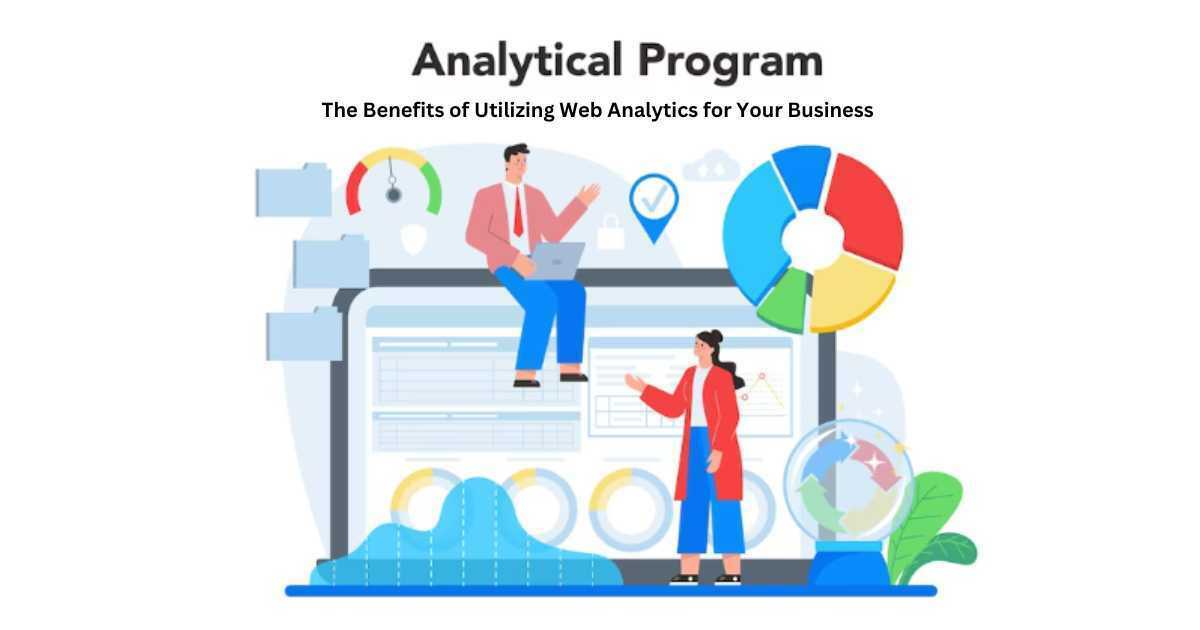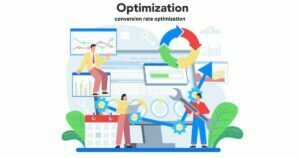Owners of businesses, take note! Do you want to improve your internet presence? Learn How to use web analytics to increase the performance of your website and your earnings! In this post, We outline The Benefits of Utilizing Web Analytics for Your Business. Don’t pass up this Essential information that could help you grow your business!
I. Introduction
Web Analytics for Your Business
A. Definition of web analytics
B. Why web analytics is important for businesses
C. Brief overview of the article
I. Introduction
A. Definition of web analytics:
Web analytics refers to the Collection, measurement, analysis, and Reporting of web Data for the purpose of understanding and Optimizing web usage.
B. Why web analytics is important for businesses:
Businesses can gain useful information from web analytics regarding their online presence, consumer behavior, and the success of their digital marketing campaigns. Businesses may enhance their online performance, boost customer happiness, and drive revenue Development by tracking indicators like Website traffic, user engagement, and conversion rates.
C. Brief overview of the article:
The advantages of online analytics for businesses, the many resources and techniques used in web analytics, and the best practices for analyzing and understanding web data will all be covered in-depth in this article.
Additionally, it will discuss typical web analytics Difficulties and hazards, as well as how to avoid them.
This article will assist you in better understanding how to use web analytics to enhance your online presence and promote Business success, whether you are a business owner, marketer, or analyst.

II. Understanding Web Analytics
A. Types of web analytics
1. On-site analytics
2. Off-site analytics
Web Analytics for Your Business
II. Understanding Web Analytics
The Process of Gathering and analyzing data from a website in order to better understand user behavior and increase Website performance is known as web analytics. The steps to comprehending Web Analytics are as follows:
- Establish your goals: Determine your website’s aims as a first step. What do you hope to achieve? Which behaviors do you want people to show? Your ability to determine the key performance indicators (KPIs) you must monitor will be aided by this.
- Install tracking software: In order to collect data, you must install tracking software on your website. Given that it is Free and simple to use, Google Analytics is a popular option. Additionally, you can make use of Technologies like Piwik, Mixpanel, or Adobe Analytics.
- Set up conversion tracking: You may monitor user behavior on your website that results in conversions by using conversion tracking. A purchase, a form submission, or a download might be involved here. You may learn which parts of your website are effective and which ones want improvement by keeping track of these actions.
- Analyze your data: After gathering data, you must examine it to draw conclusions. Pageviews, Bounce rate, session length, and conversion rate are a few indicators to consider. To analyze data by various user categories, such as Demographics, Geography, and device kind, use segmentation.
- Identify trends and patterns: Analyze your data for trends and patterns. Do certain pages in particular generate more traffic than others do? Is there a peak period of activity on your website during the day? You may make wise decisions regarding your website by recognizing trends.
- Take a move: Make adjustments to your website using the knowledge you acquired from your research. You may change the user experience, for instance, if you notice that users are Leaving a certain page. You can increase your investment in a Marketing campaign if you Discover that it is generating a lot of Visitors.
- Follow your Development: Keep checking your statistics to monitor the status of your goals. A/B testing is a Method for comparing the performance of various Website versions.
- Follow your Development: To keep track of your Goals’ Progress, keep Checking your Statistics. A/B Testing can be used to Compare the performance of various Website Versions.
By Doing the Steps indicated here, you can better understand the functionality of your Website and decide How to Make Improvements.
A. Types of web analytics
1. On-site analytics
2. Off-site analytics
Web Analytics for Your Business
On-Site Analytics and Off-Site Analytics are the Two main Categories for Web Analytics.
- On-site analytics: Analytics that are performed on your own website are referred to as on-site analytics. Metrics like pageviews, bounce rate, session length, and conversion rate fall under this category. You can monitor user behavior, pinpoint problem areas, and improve the speed of your website using on-site analytics tools. Google Analytics, Adobe Analytics, and Piwik are a few examples of on-site analytics solutions.
- Off-site analytics: Off-site analytics is the term for the study of user behavior on websites other than your own. Metrics like referral traffic, social media participation, and search engine rankings fall under this category. You may track the success of your marketing initiatives, keep tabs on the internet perception of your company, and look for collaboration and outreach opportunities using off-site analytics tools. Off-site analytics solutions like Buzzsumo, SEMrush, and Ahrefs are instances.
For a thorough understanding of the operation of your Website and the effectiveness of your efforts to sell it online, both on-site and off-site Analytics are essential. You may Understand user behavior at every stage of the customer journey and Make Data-Driven Decisions to enhance your Online Presence by integrating the two Forms of analytics.
B. How web analytics works
1. Collecting data
2. Analyzing data
3. Reporting data
Web Analytics for Your Business
B. How web analytics works
Web analytics is the process of gathering, evaluating, and reporting statistics on website traffic and user activity. Monitoring website user behavior is keeping track of the websites visitors visit, how long they stay on each, and the actions they take. Here is a brief description of web analytics’ operation:
- Collecting data: This involves utilizing tracking technologies, like cookies or JavaScript, to collect data about website visitors and their interactions with the website. These details could include the visitor’s physical location, technological setup, web browser, and online behaviors.
- Analyzing data: Data can be analyzed after it has been gathered to reveal information about user behavior and website performance. This may need undertaking data analysis using programs like Google Analytics or Adobe Analytics in order to spot patterns, trends, and areas that need improvement.
- Reporting data: Reports can be produced using the data amassed through data analysis to assist advertisers and website owners in evaluating the effectiveness of their websites and in making knowledgeable decisions. Website traffic, conversion rates, and user behavior are just a few of the statistics that may be used to improve website content, design, and marketing tactics.
Overall, web analytics is a valuable tool for understanding website performance and user behavior, and can help businesses and organizations make informed decisions about their online presence.
III. Benefits of Web Analytics
A. Improving website traffic and user experience
1. Identifying popular pages and content
2. Understanding user behavior
3. Optimizing website design and layout
Web Analytics for Your Business
III. Benefits of Web Analytics
A. Improving website traffic and user experience
Web analytics gives a variety of statistics about user behaviour and website performance to boost website traffic and user experience. Web analytics has the following specific benefits:
- Identifying popular pages and content: Web analytics tools can look at website traffic statistics to figure out which pages and content are visited the most frequently. This data can be utilized to Create material that is more engaging for website visitors and to better position it there.
- Understanding user behavior: Web analytics software can monitor user activity on a website, including where visitors Spend the most time, how they move about the site, and which pages they leave. In addition to Helping to improve the user Experience, this Data can be utilized to spot potential trouble spots for users.
- Optimizing website design and layout: Web analytics may provide information about how visitors interact with the structure and design of a website. Website Designers can update a website’s design and layout to better suit users’ requirements and preferences by Analyzing data on user behavior and Traffic patterns.
Web analytics, in General, can help organizations make Data-driven Decisions about How to effectively optimize their Websites while also Improving Website Performance and User experience.
B. Boosting conversion rates
1. Analyzing conversion funnels
2. Identifying drop-off points
3. Implementing changes to improve conversions
Web Analytics for Your Business
B. Boosting conversion rates
- Analyzing Conversion Funnels: Analyzing the complete conversion funnel is essential for improving conversion rates. This involves working out the various funnel stages and the activities users take at each one. You may learn where people leave a site and where there may be room to improve the conversion rate by studying the funnel.
- Identifying Drop-Off Points: You can locate the places where users are leaving after analyzing the conversion funnel. This may be the result of a number of things, like a challenging checkout procedure, ambiguous product descriptions, or website technical difficulties. You can concentrate on making improvements to fix the problems and raise the conversion rate by locating these drop-off spots.
- Implementing Changes to Improve Conversions: Based on the analysis of the conversion funnel and identification of drop-off points, you can implement changes to improve conversions. This could include simplifying the checkout process, optimizing product descriptions and images, improving website loading speed, or adding social proof such as customer reviews. It’s important to test these changes and measure their impact on conversion Rates, so you can continue to optimize and improve the funnel over time.
C. Tracking marketing performance
1. Measuring ROI
2. Identifying effective marketing channels
3. Refining marketing strategies
Web Analytics for Your Business
C. Tracking marketing performance
- Measuring ROI: Return on Investment, or ROI, is a statistic used to assess how profitable an investment is in comparison to its cost. Divide the revenue from a marketing campaign by the campaign’s cost to determine ROI in the context of marketing. ROI measurement is crucial since it enables firms to identify which advertising campaigns are profitable to fund and which ones aren’t.
- Identifying effective marketing channels: Businesses can use a variety of marketing platforms, including social media, email marketing, search engine marketing, and more. A firm can more effectively use its marketing budget and reach its target audience by determining which marketing channels are most effective for that particular business. Analyzing data on variables like consumer demographics, Engagement rates, and conversion rates for each Channel is necessary for doing that.
- Refining marketing strategies: A company can start fine-tuning its Marketing tactics to increase results once it has evaluated its ROI and determined the best marketing channels. Changing the messaging or imagery used in Marketing Campaigns, testing out various Marketing Platforms, or selecting a different target market are all examples of how to do this. Based on data and customer feedback, Businesses can continually refine their marketing strategy to increase the effectiveness of their Marketing efforts.
IV. Implementing Web Analytics
A. Choosing the right web analytics tool
1. Google Analytics
2. Adobe Analytics
3. Piwik
web analytics
A. Choosing the right web analytics tool
Any website owner’s toolset must include web analytics because it is essential for monitoring website performance and user behaviour. Understanding the traffic, user interaction, and conversion rates to your website depends greatly on the web analytics platform you choose. Here are three well-liked choices to think about:
- Google Analytics: One of the most popular online analytics tools available is Google Analytics and for good reason. Real-time reporting, audience segmentation, conversion monitoring, and E-commerce tracking are just a few of the many functions it provides. Additionally, the majority of customers can use it for free, making it a Cost-effective choice for Companies of any size.
- Adobe Analytics: The more advanced Web Analytics tool Adobe Analytics is meant for larger Companies. It offers a wide range of potent features, such as enhanced Segmentation, data visualization, and forecasting. It can be more Expensive than other Choices, though, So larger Businesses with larger Budgets may find it more suitable.
- Piwik: Rather than relying on a third-party supplier, Piwik is an open-source web analytics solution that enables you to host your own analytics data on your own server. Real-time reporting, visitor tracking, and goal tracking are just a few of the capabilities available. Businesses that respect data security and privacy should consider this option because it gives them control over their own data.
It’s critical to take into account both your budget and unique needs when selecting a web analytics solution. Consider your options carefully and compare each tool’s Capabilities and pricing before choosing one. The tool’s usability and compatibility with your Website should also be taken into account because they may affect how quickly you can begin analyzing your data.
B. Setting up web analytics
1. Installing tracking codes
2. Setting up goals and conversions
3. Configuring reports and dashboards
web analytics
B. Setting up web analytics
It’s time to set up the web analytics tool you’ve selected so it can begin monitoring the Performance of your website. For setting up Web analytics, Follow these three Basic steps:
1. Installing tracking codes:
Installing the Tracking code that your Web analytics solution provides on your Website is the First step. The tool’s ability to Gather information about the users of your Website and their behavior Depends on this code. Depending on the tool you’re using, the installation process will vary, but generally involves copying and pasting the code into the header or footer of your website’s pages.
2. Setting up goals and conversions:
Setting up the goals and conversions you want to track on your website is the next step. Goals are particular activities you want site visitors to do, such as downloading content, completing a form, or buying something. The number of visitors who reach these objectives is known as a conversion. You can monitor how effectively your website is attracting users and generating conversions by putting up these goals and conversions.
3. Configuring reports and dashboards:
It’s time to create your reports and dashboards after you’ve installed the tracking code and established your goals and conversions. Reports offer comprehensive information on the performance of your website, including the number of visitors, the pages they view, and the activities they do. Dashboards make it simple to see how effectively you’re meeting your goals by giving a high-level visual summary of the performance of your website.
You might be able to modify your reports and dashboards to display the precise metrics that are most significant to you, Depending on the tool you’re using. Setting up web analytics is a critical first step in learning how your website is doing and Enhancing its efficiency. By doing these actions, you may begin Gathering useful information about the users of your website and using it to Guide decisions about your Digital strategy.
V. Conclusion
A. Recap of the benefits of web analytics
B. Encouragement to implement web analytics for business success
C. Final thoughts and additional resources.
Understanding the functionality and user behavior of your website may be done with the Help of Web analytics. Businesses may Increase the performance of their websites and their Digital strategy by Tracking and analyzing data. The advantages of Web Analytics are summarized as follows:
- Determine the sources of your website’s traffic and examine user behavior there.
- Goals and conversions are measured and tracked.
- Identify your website’s shortcomings.
- optimize website content and advertising campaigns
Even though putting web analytics into practice can seem overwhelming, doing so is a must for business success. Understanding how visitors utilize your website will help you make wise decisions that will increase conversions and boost user engagement. If you haven’t done so already, think about implementing web analytics to learn more about how well your website is performing and to help you make informed decisions.
In conclusion, Web analytics is a potent tool for companies of all sizes, to sum up. You can learn a lot about the performance of your website and make wise choices about your digital strategy by monitoring and analyzing data. Take the time to research and select the best web analytics solution for your company among the many that are available. Don’t be concerned to look into the many resources that are accessible to you to help you learn more about web analytics and how to use it successfully.
Here are some frequently asked questions about web analytics:
Q. What is web analytics?
A. Data about website traffic and user behavior is Collected, analyzed, and Reported through the process of web-analytics. It’s an essential tool for Understanding user Behavior on your Website and enhancing its efficiency.
Q. Why is web analytics important?
A. Web-analytics are essential because they give organizations insightful data about the functionality and user behavior of their websites. Businesses can improve user engagement, increase conversions, and optimize their Digital strategy by tracking and Analyzing data.
Q. What kind of data can web analytics track?
A. The number of visitors to your Website, their duration on your site, the pages they visit, the actions they do (such as submitting a form or making a purchase), and their Location may all be tracked using web analytics.
Q. What are some popular web analytics tools?
A. Setting up the goals and conversions you want to track is the first step in using web-analytics to improve your Website. Then, use data analysis to identify your website’s weak points, such as pages with high bounce rates or low conversion rates. Make Data-driven decisions based on this information to Maximize the effectiveness of your website.
Q. How do I use web analytics to improve my website?
A. Start by establishing the Goals and conversions you want to Track before using web Analytics to improve your website. Then, Analyze your data to find places on your Website that could use improvement, such as pages with high bounce rates or poor conversion rates. Make data-driven decisions with the use of this Knowledge to increase the efficiency of your Website.
In general, Web analytics is an essential tool for companies that wish to understand the performance of their website and enhance their digital strategy. Businesses may make wise decisions that increase conversions and user Engagement by Monitoring and Analyzing data.
Also, Read- 10 Reasons Why Your Business Needs HubSpot Marketing Automation Tools
Also, Read- What Digital Marketing Is All About? Digital Marketing Blogs




